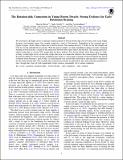Files in this item
The rotation-disk connection in young brown dwarfs : strong evidence for early rotational braking
Item metadata
| dc.contributor.author | Moore, Keavin | |
| dc.contributor.author | Scholz, Aleks | |
| dc.contributor.author | Jayawardhana, Ray | |
| dc.date.accessioned | 2019-03-05T16:30:12Z | |
| dc.date.available | 2019-03-05T16:30:12Z | |
| dc.date.issued | 2019-02-20 | |
| dc.identifier | 258058535 | |
| dc.identifier | f268b083-83e5-4956-8e02-124ef436a298 | |
| dc.identifier | 000459323800012 | |
| dc.identifier | 85063450893 | |
| dc.identifier | 000459323800012 | |
| dc.identifier.citation | Moore , K , Scholz , A & Jayawardhana , R 2019 , ' The rotation-disk connection in young brown dwarfs : strong evidence for early rotational braking ' , Astrophysical Journal , vol. 872 , no. 2 , 159 . https://doi.org/10.3847/1538-4357/aaff5c | en |
| dc.identifier.issn | 0004-637X | |
| dc.identifier.other | BibCode: 2019ApJ...872..159M | |
| dc.identifier.uri | https://hdl.handle.net/10023/17222 | |
| dc.description | This work was supported in part by a McGill University Tomlinson Doctoral fellowship to K.M., NSERC grant to R.J. and by STFC grant ST/R000824/1 to A.S. | en |
| dc.description.abstract | We use Kepler/K2 light curves to measure rotation periods of brown dwarfs and very low mass stars in the Upper Scorpius star-forming region. Our sample comprises a total of 104 periods. Depending on the assumed age of Upper Scorpius, about a third of them are for brown dwarfs. The median period is 1.28 day for the full sample and 0.84 day for the probable brown dwarfs. With this period sample, we find compelling evidence for early rotational braking in brown dwarfs, caused by the interaction between the central object and the disk. The median period for objects with disks is at least 50% longer than for those without. Two brown dwarfs show direct signs of "disk-locking" in their light curves, in the form of dips that recur on a timescale similar to the rotation period. Comparing the period samples for brown dwarfs at different ages, there is a clear need to include rotational braking into period evolution tracks between 1 and 10 Myr. A locked period over several Myr followed by spin-up due to contraction fits the observational data. We conclude that young brown dwarfs are affected by the same rotational regulation as stars, though they start off with significantly faster rotation, presumably set by initial conditions. | |
| dc.format.extent | 20 | |
| dc.format.extent | 4493960 | |
| dc.language.iso | eng | |
| dc.relation.ispartof | Astrophysical Journal | en |
| dc.subject | Accretion, accretion disks | en |
| dc.subject | Brown dwarfs | en |
| dc.subject | Stars: formation | en |
| dc.subject | Stars: rotation | en |
| dc.subject | QB Astronomy | en |
| dc.subject | 3rd-DAS | en |
| dc.subject.lcc | QB | en |
| dc.title | The rotation-disk connection in young brown dwarfs : strong evidence for early rotational braking | en |
| dc.type | Journal article | en |
| dc.contributor.sponsor | Science & Technology Facilities Council | en |
| dc.contributor.sponsor | Science & Technology Facilities Council | en |
| dc.contributor.institution | University of St Andrews. School of Physics and Astronomy | en |
| dc.contributor.institution | University of St Andrews. St Andrews Centre for Exoplanet Science | en |
| dc.identifier.doi | https://doi.org/10.3847/1538-4357/aaff5c | |
| dc.description.status | Peer reviewed | en |
| dc.identifier.url | https://arxiv.org/abs/1901.05523 | en |
| dc.identifier.url | http://adsabs.harvard.edu/abs/2019ApJ...872..159M | en |
| dc.identifier.grantnumber | ST/R00824/1 | en |
| dc.identifier.grantnumber | ST/M001296/1 | en |
This item appears in the following Collection(s)
Items in the St Andrews Research Repository are protected by copyright, with all rights reserved, unless otherwise indicated.

